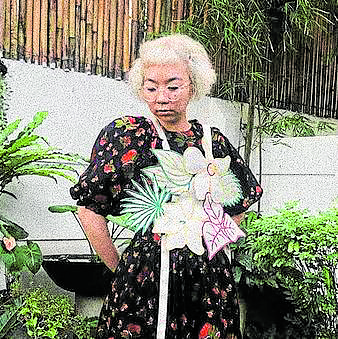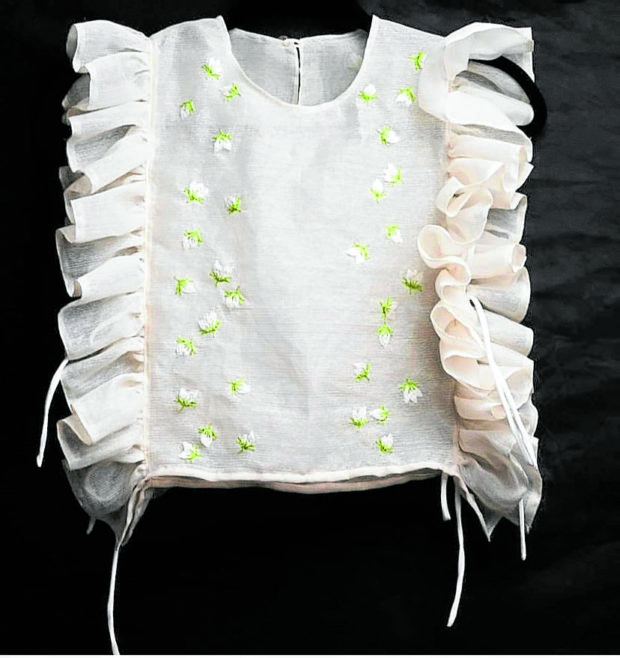Gabbie Sarenas describes Filipino embroidery as a love letter to the Philippines. That it is unique because it comes from dreams.
“The allure is the mystique that it brings to a tangible item. It’s something that is imperfect and bears no use of a machine, which brings value and culture of the hands,” the young designer said.
Sarenas hosted an embroidery workshop on Facebook on April 22 to launch the new Uniqlo and JW Anderson collection.
The Spring/Summer line features wildflower embroidery and blanket stitching that can be found on T-shirts, hats, tote bags, socks and other pieces. The collection also makes use of satin stitching. Both techniques were taught by Sarenas along with backstitch, lazy daisy and French knot during the workshop.
There are plenty of backstitches in Sarenas’ collection, but she has also proven that embroidery can go beyond the tiny, dainty flowers through her the Hindrika Bouquet apron. The accessory meant to be worn to complete an ensemble is composed of giant flowers embroidered with satin stitch on piña shifu.
Sarenas explained that embroidery can mean different things to different cultures. It is used to mend clothes or to add to design. In the Philippines, it can also indicate social status. Ladies during the Spanish colonial period were praised for their needlework.

“Hands are our culture. It gives us a storyline of our time in the world that’s passed on from generation to generation,” she said.
We asked if one needle can be used for all designs. Sarenas said that the choice of needle is not dependent on the design, but on the fabric weight. A needle threader can also be a very important tool, and not only for those with bad eyesight, because an embroidery thread consists of several strands that often get caught in the eye of the needle.
Sarenas said that one of the challenges of learning embroidery is that it is a skill that can be learned slowly. People who give up tend to be impatient. Her advice is “to be patient, take your time and practice. If you get tired, take a break and go back when you’re ready.”

Embroidery is therapeutic, she said. You can always start over when you make a mistake. She suggests drinking coffee or tea while listening to music when you do it.
Sarenas said, “Embroidery is a skill that can be learned by anyone. It involves a lot of patience, which is rewarded at the end.”
Here are three stitches you can use to personalize any outfit.
What you need:
Embroidery needle
Embroidery thread
Pin cushion
Scissors
Thimble
Needle threader
Embroidery hoop
How to do it:
1. Prepare your design. “Make things easy by drawing on your textile beforehand with a pencil or, better yet, water-soluble pen,” Sarenas advised. You can create your design or you can download patterns online.
2. Backstitch is used when you need to do an outline. This can be used for securing seams. From the bottom of your fabric, just go in with your threaded needle and thread back a couple of stitch lengths forward.
To create the next stitch, go forward, just a short distance from your first stitch and connect to the end or tail of your last stitch. Shorten the stitch length if you want to make a sturdier stitch or if you want to do curves, she said.

3. Satin stitches are used to fill out spaces to make embroidery pop, said Sarenas. They can be used to create flowers or leaves. She described them as showstoppers.
To do satin stitches, you have to stick your needle in the lower end of the pattern and go upward to create a vertical line. The goal is to fill in the repetitions of vertical stitches. “This technique requires a lot of patience. So take your time. Make sure not to pull too tight as it creates clumps on your fabric.”
4. A blanket stitch is used to secure the edges of the fabric or clothing. Bring the needle out from the back of the fabric and pull the thread all the way through. Stick the needle on the right side, diagonally from the starting point. Go back up to anchor the thread to create a reverse letter L. Then pull the thread up. You have to keep repeating the process until you completely cover the desired area. INQ











































